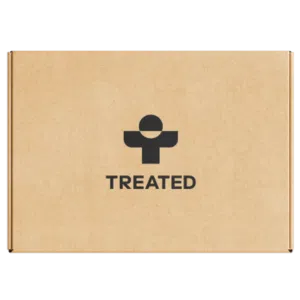Make warts disappear fast with combined treatment.


Salactol is a solution you apply straight to warts and verrucas. It dissolves the infected skin and kills the virus, allowing your skin to grow back healthy.
Order Salactol online with Treated. We’ll make your wart or verruca treatment simple, discreet and personalised to you.
Salactol is a syrupy solution used for warts and verrucas, that gets rid of them quickly and effectively. It’s often called wart paint, because you paint it straight onto the affected skin. It sheds the outer layer of skin and gets rid of the infection, leaving you with clear and healthy skin.
Warts and verrucas are skin conditions both caused by the same virus, so they can be treated the same way. The main difference is that verrucas only appear on the feet, while warts can show up anywhere. So no matter which you have, Salactol can help.
There are two active ingredients in Salactol, salicylic acid and lactic acid. The salicylic acid is a type of treatment for warts and verrucas known as a keratolytic. This means it works in two ways to get rid of the warts or verrucas. It removes the outer layer of skin where the virus lives by softening it, so it can shed more easily. The dead, infected skin cells also bind easily to the Salactol, so they are easily removed.
It kills off the virus causing the warts and verrucas, so the skin doesn’t get reinfected. The lactic acid in Salactol helps dissolve the dead skin cells infected with the wart virus, by working as an exfoliant. Lactic acid also makes the salicylic acid work more effectively.
There’s only one dose of Salactol. It comes as a 10ml bottle which has 16.7% of salicylic acid and 16.7% of lactic acid. You apply it once a day, usually in the evening. You should put just enough Salactol onto the wart or verruca to cover it. The applicator is specially designed to release just a few drops, as needed.
If this dose isn’t working for you, remember it could take a few weeks to see improvements if your wart or verruca infection is advanced. If it’s been nearly twelve weeks, you may want to go back to your clinician. You can log into your account and message us if you’ve ordered through Treated.

How we source info.
When we present you with stats, data, opinion or a consensus, we’ll tell you where this came from. And we’ll only present data as clinically reliable if it’s come from a reputable source, such as a state or government-funded health body, a peer-reviewed medical journal, or a recognised analytics or data body. Read more in our editorial policy.
Always follow your clinician’s advice on how to use Salactol.
How long you need to use Salactol for will depend on the size of the wart or verruca. Some warts or verrucas will disappear very quickly, while others may take longer. Don’t stop using Salactol until the wart or verruca is completely healed.
Generally, warts and verrucas should be completely gone after twelve weeks of treatment. So you may want to go back to your clinician for more advice if it’s been that long and you haven’t seen an improvement.
Only apply Salactol on skin that’s infected with warts or verrucas. It’s not meant for healthy skin, and may irritate it. If you do accidentally paint Salactol onto normal skin, wash it off with clean water. If the irritation carries on, you might want to talk to your clinician.
Keep Salactol away from your eyes, nose and mouth. Don’t apply it to moles or birthmarks. Wash it off thoroughly if you accidentally get some there by accident. Try not to get it on your clothes, as you may damage them. You can try covering the area around where you’re applying Salactol to avoid spilling any.
The collodion in Salactol is very flammable. Make sure to keep the liquid away from open flames. Keep the skin that’s been in contact with Salactol away from flames for a while after using it. Don’t worry if you forget to use Salactol occasionally. Just keep using it as normal when you remember.

How we source info.
When we present you with stats, data, opinion or a consensus, we’ll tell you where this came from. And we’ll only present data as clinically reliable if it’s come from a reputable source, such as a state or government-funded health body, a peer-reviewed medical journal, or a recognised analytics or data body. Read more in our editorial policy.
Have something specific you want to know? Search our info below, or ask our experts a question if you can’t find what you’re looking for.

Registered with GMC (No. 4624794)
Meet Daniel
Registered with GPhC (No. 2202465)
Meet Sanjeda
Registered with GPhC (No. 2070724)
Meet Craig We know health, but you know you.
Our experts tell you what’s safe, but you decide what’s best.
Answer a few questions and tell us about yourself. Get tailored advice from our clinicians so you can choose better.

Choose your treatment and how often you have it delivered.

We know things change. It’s the nature of life. We’ll check in regularly to make sure your treatment is still right for you.
Pause. Change. Skip. Start again. Any time you like.
Always arrives on time and I’m kept informed of progress.
Excellent
I have had it previously from my G.P so It worked as expected, extremely well. My problem is an accessing my G.P practice, they put ED well down their list of priorities. I found your service excellent, quick and efficient. I fully intend to continue using it
5 star
Reliable company
Shipping is speedy and the product is amazing.
Fast, slick service. Very easy to amend subscription when required.
All good.
Great service
Really helped me
Trusted service and great service - next day delivery and I can rely on them to send regularly.
Ordering was straight forward, tablets delivered promptly and well packaged, and instructions were clear, thanks.
100% recomended.Great service
Excellent service
Excellent delivery. Can’t fault.
Quick and efficient service, delivered discreetly the next day. Thank you.
Effective
Great service, no wait time
Great
Quick assessing for medicine suitability. Quick delivery and good communication throughout.
Straightforward and quick service!
Good however communication could sometimes be better
Easy and good procedure to get treatment
Excellent product
Excellent service!!! Ordered what I needed sent a picture of my prescription and the parcel arrived the next day!!! Will definitely order again and have recommended to others!!!
Fast shipping
Very quick service all round
So quick and simple. Recommend
Great
Very convenient hassle free service.
Easy to use good communication and fast shipping
Great service
Efficient no issues re delivery
Fabulous service
Brilliant service. Not a bad word to say!
It was fast, professional and it's the right med for what I selected in there.
This review requires content. Oh well..
Great service, quite effortless.
Top notch
Brill service
N/a
Excellent service quick and easy to use
Fast and exact order
Superb service and quick delivery 10/10
Excellent service
Thank you for fast delivery
Shipping is extremely quick and satisfiying
Good stuff
Good service
Great fast delivery
Warts: Here are some other options.
Effective first-line treatment for warts available in two strengths.
We're making healthcare more about you. Sign up to our newsletter for personalised health articles that make a difference.
Disclaimer: The information provided on this page is not a substitute for professional medical advice, diagnosis, or treatment. If you have any questions or concerns about your health, please talk to a doctor.
Liquid nitrogen and salicylic/lactic acid paint in the treatment of cutaneous warts in general practice. The Journal of the Royal College of General Practitioners. 38,311, 256-8.
Salactol Collodion - Summary of Product Characteristics (SmPC) - (emc). [online] Available at: [Accessed 7 Mar. 2022].
We couldn't find what you're looking for.
Here's everything we treat. Or, if you're looking for something we don't have yet, you can suggest something.
If there’s a particular treatment or condition you’re looking for, tell us and we’ll look into it for you.
Submit your question here, or tell us if you’ve found an issue on our site.
We’ll get back to you very soon. We aim to respond to all queries in one working day.
You’re signed up to our newsletter. Keep an eye on your inbox for our latest update.
By clicking 'Subscribe now' you're agreeing to our Privacy Policy.
We’ve sent you an email asking you to confirm your email address.